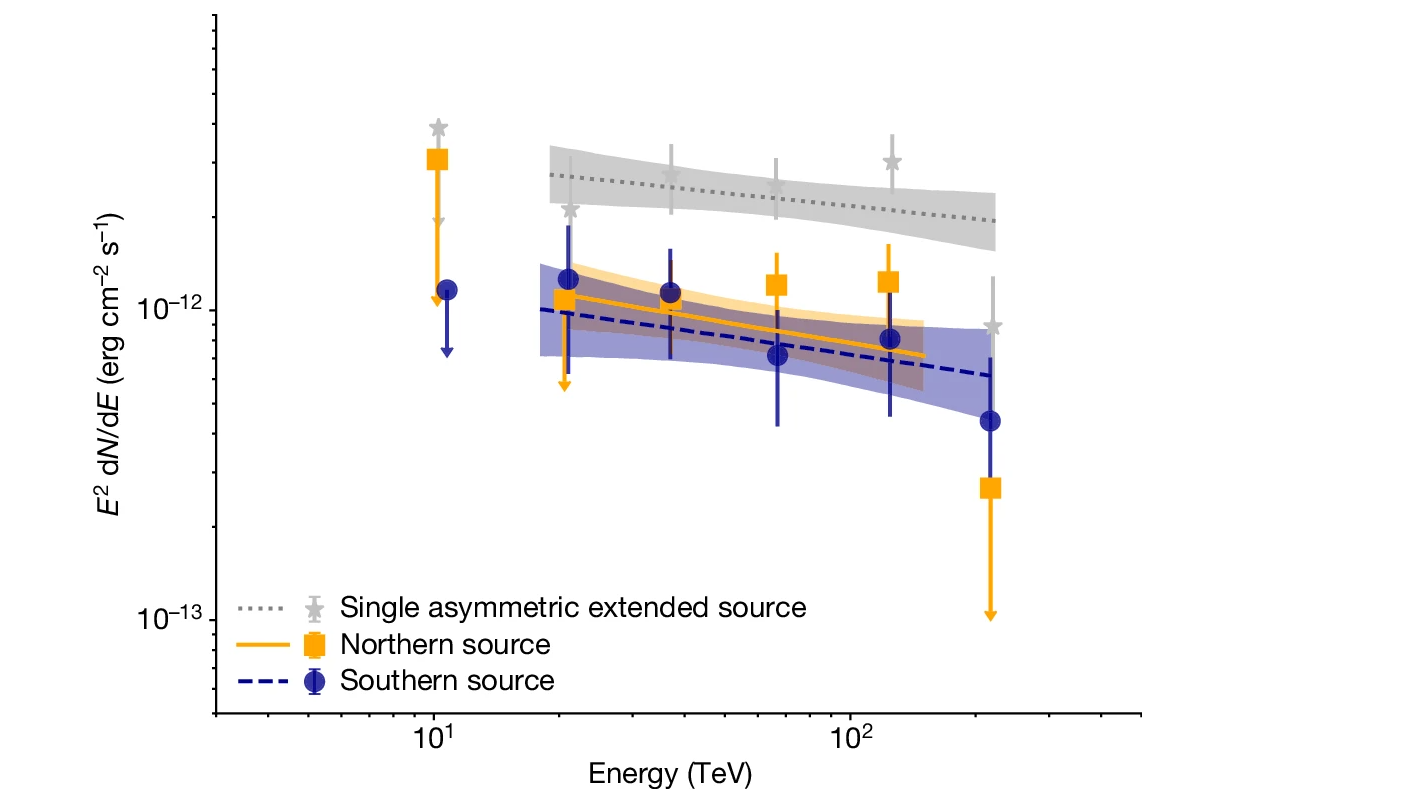A new study in Nature, “Ultra-high-energy gamma-ray bubble around microquasar V4641 Sgr," has revealed a groundbreaking discovery by researchers from the High Altitude Water Cherenkov (HAWC) observatory: TeV gamma-ray emissions from V4641 Sagittarii (V4641 Sgr), a binary system composed of a black hole and a main sequence B-type companion star. This discovery provides fresh insights into particle acceleration in large-scale jets emitted from microquasars, which serve as natural laboratories for studying high-speed jets produced by matter falling onto spinning black holes. The findings show that V4641 Sgr's gamma-ray emissions occur at similar distances from the black hole as those observed in another well-known microquasar, SS 433. This makes V4641 Sgr stand out for its super-Eddington accretion and one of the fastest superluminal jets in the Milky Way. With a gamma-ray spectrum that ranks among the hardest of any known TeV sources, the emissions are detected at energies exceeding 200 TeV.  Schematic illustration of the V4641 Sgr region.
Schematic illustration of the V4641 Sgr region.
The study's results indicate that the gamma rays are likely produced by extremely high-energy protons. While studies of SS 433 indicate that the emission from this object is likely electrons, the high energy emission at large distances from V4641 argue against electrons due to their rapid energy loss at high energies. The implications are profound: the environment around the microquasar may play a critical role in determining whether the emission from the large-scale jets comes from electrons or protons, and they could play a significant role as a source of Galactic cosmic rays. These observations open new avenues for understanding particle acceleration in extreme environments and contribute to the broader study of high-energy astrophysics.
"At a zenith angle of 46° from HAWC's field of view, the microquasar V4641 Sgr has accelerated particles to the knee of the cosmic-ray spectrum, pushing the boundaries of our understanding of particle acceleration and transport in such extreme environments," said Dr. Dezhi Huang, a Post-Doctoral researcher at the University of Maryland. "HAWC observatory continues to deliver exceptional performance, providing valuable insights into these high-energy processes that were previously beyond our reach. "
“The HAWC survey has discovered for the first time very high energy gamma rays from the extended 100 pc jet of the microquasar V4641 Sgr. This proves that jets launched in accreting systems can accelerate particles up to PeV energies, and therefore that microquasars are potentially significant contributors to the Galactic cosmic ray population at high energies," saidDr. Sabrina Casanova, Professor from Institute of Nuclear Physics of the Polish Academy of Sciences. "Furthermore, although very high energy protons are strongly suspected to exist in the kpc jets of active galactic nuclei (AGN), the associated hundred TeV emission has never been observed from an extended region from an AGN jet due to strong gamma-ray absorption over the long distances to Earth.” Differential spectrum weighted by E2 for the northern and southern sources in a model with two point sources and for the asymmetric extended source in a model with a single asymmetric extended source. The shaded regions indicate the best-fit spectra and 1σ statistical uncertainties when fitting a single-power-law model to the data from 10 to >200 TeV. The markers correspond to the best-fit values and their 1σ statistical uncertainties obtained when fitting a single-power-law model to data in individual energy bins. The chosen energy range for plotting the spectrum is specified in the Methods.
Differential spectrum weighted by E2 for the northern and southern sources in a model with two point sources and for the asymmetric extended source in a model with a single asymmetric extended source. The shaded regions indicate the best-fit spectra and 1σ statistical uncertainties when fitting a single-power-law model to the data from 10 to >200 TeV. The markers correspond to the best-fit values and their 1σ statistical uncertainties obtained when fitting a single-power-law model to data in individual energy bins. The chosen energy range for plotting the spectrum is specified in the Methods.
This study was supported by the collaborative efforts of multiple institutions, with major contributions from the University of Maryland. Distinguished University Professor Jordan Goodman, a member of the collaboration's internal editorial board, played a key role in guiding the publication. Dr. Dezhi Huang, one of the corresponding authors, led significant aspects of the analysis, while Dr. Kristi Engel helped refine the paper. Additional support came from UMD HAWC group members Research Scientist Dr. Andrew Smith, Project Engineer Michael Schneider, Dr. Zhen Wang, Dr. Jason Fan and graduate students Sohyoun Yun-Cárcamo.
More on the finding: https://www.nature.com/articles/d41586-024-03191-x